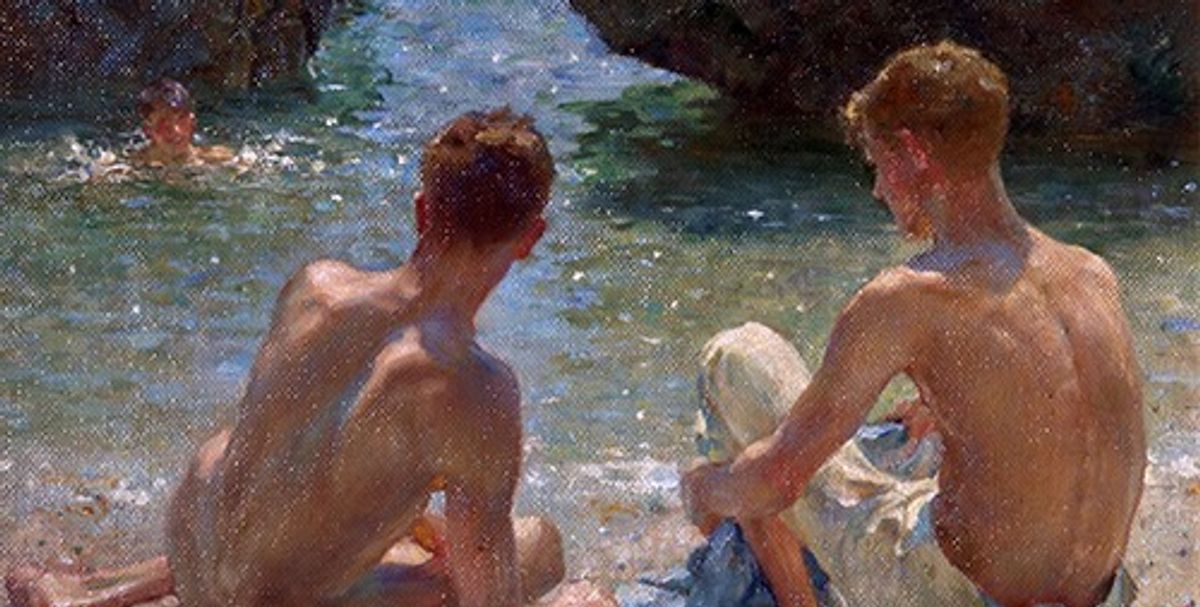Perhaps the greatest exhibit at the Tate Britain exhibition Queer British Art, 1861-1967, is the sign on the door to the facilities reading “all gender toilets”. Next to it is a lustrous array of mythopoeic paintings by Simeon Solomon, who was arrested in a Parisian pissoir for “indecent touching”. There is a vast disconnect here—as there still is in the greater world, where LGBTQ people are still being prosecuted and, in some countries, executed for the crime of loving differently.
The 150 or so works included in this show are caught between two dates: the British abolition of the death penalty for sodomy in 1861 and the decriminalisation of some sexual acts between men in 1967.
On the one hand, we have the incredible creativity of more than a century of art; on the other, we have the external narrative of despair imposed upon that work and the lives of the artists who made it. When Solomon portrays androgynes and barely coded homosexuality in his dreamy, fin-de-siècle other world, or when John Craxton, who regarded himself as an Arcadian, paints Peter Watson, the aesthete and chief benefactor of London’s Institute of Contemporary Arts, dancing through a neo-Romantic landscape in 1948, these disparities, aspirations and realities are brought forcefully yet nebulously into focus in the way that only art can do.
There is intrinsic value in bringing this subversive material into a temple of the establishment. Look at Edward Burra’s huge watercolour Soldiers at Rye (1941), which on close examination looks more like a collage of surreal, mask-wearing figures. It is bursting with physicality. In the tension that Burra captures between the appealing masculine soldiers and the knowing viewers of the work, he has his little revenge on the straight world. The work is a hymn to the (sometimes) untouchable.
So much of the work in the show is about performance because queer people have always had to perform—first to disguise their real selves, but at the same time to express their realities. Thus the socialite Stephen Tennant plays Prince Charming in Cecil Beaton’s exquisite photograph of 1927, lying like a medieval tomb figure but draped in satin and pearls. No wonder Caroline Blackwood, the former wife of Lucian Freud, told me when I was writing Serious Pleasures, a biography of Tennant, that the only person to whom she could compare him was David Bowie. (Freud himself spoke affectionately of Tennant to me, too, as if he were a queer pet.) Later, lost in his own fantasies of pre-war Marseilles, Tennant created elaborate pen-and-ink drawings of tough lascars (South Asian sailors) bedecked with roses. One of these drawings, lent by one of his contemporary champions, Viktor Wynd, hangs in the show.
And then there are the private moments. When Maud Allan—the “Salomé Dancer,” so named for a ballet she produced that was based on Oscar Wilde’s play—dances in her see-through ninon skirt in a carte de visite, her bosom bedecked in more pearls than Jean-Paul Gaultier’s brassiere for Madonna, she does so for private delectation. Allan was probably one of the first women to be publicly accused of lesbianism. In 1918, the politician and rabid homophobe Noel Pemberton Billing was supposedly outraged by her performance; he identified her as the leader of a “Cult of the Clitoris”. Pemberton Billing was using Allan and the residual decadent memory of Wilde to stir up war hysteria to his own ends. Indeed, one of the most moving exhibits in Queer British Art is the cell door behind which Wilde was kept at Reading gaol after he was imprisoned for homosexuality in 1895. Next to it stands a full-length portrait of the inmate looking as if he had only just stepped out from behind the door.
The eclectic essays in the accompanying catalogue (edited by Clare Barlow, with contributions from writers such as Neil Bartlett and Ilsa Colsell) underline that many of the artists represented in the exhibition would be regarded as “minor” figures. That, of course, is their appeal. It is strange to tour these rooms in the company of other people—the self-selected “public”—because it is like leafing through a private album. A tin filled with soldiers’ buttons, taken from sexual partners by the artists Denis Wirth-Miller and Richard Chopping in the 1940s, speaks eloquently of this hidden world.
There are notable lacunae in this exhibition. Where, for instance, is the work of Denton Welch, a wonderful queer artist beloved by John Waters and William Burroughs? Desire is both found and lost in these solemn rooms on the banks of the Thames. The lazily stretching bronze nude of Frederic Leighton’s The Sluggard (1885), the boy in the shower in David Hockney’s Cleanliness is Next to Godliness (1964), Noël Coward’s red silk dressing gown—all are stage-managed lives of revelation and concealment. What on earth would they have made of these visitors, this benediction, this fuss? As the actor Ernest Thesiger is suppoed to have said of the First World War, “My dear, the noise! And the people!”
• Philip Hoare is professor of creative writing at the University of Southampton. His books include biographies of Stephen Tennant and Noël Coward, and the study Wilde’s Last Stand: Scandal, Decadence, Conspiracy and the First World War
• Queer British Art 1861-1967, Tate Britain, London, until 1 October


